HTTP Client
With the HTTP Client plugin, you can create, edit, and execute HTTP requests directly in the WebStorm code editor.

There are two main use cases when you need to compose and run HTTP requests:
When you are developing a RESTful web service and want to make sure it works as expected, is accessible in compliance with the specification, and responds correctly.
When you are developing an application that addresses a RESTful web service. In this case, it is helpful to investigate the access to the service and the required input data before you start the development. During the development, you may also call this web service from outside your application. This may help locate errors when your application results in unexpected output while no logical errors are detected in your code and you suspect that the bottleneck is the interaction with the web service.
HTTP requests are stored in .http and .rest files and are marked with the icon.
Support for HTTP files includes the following features:
Code completion for hosts, method types, header fields, and endpoints defined via OpenAPI
Code folding for requests, their parts, and response handler scripts
Reformat requests according to your HTTP Request code style.
Inline documentation for request header fields and doc tags
Viewing a structure of HTTP requests
Language injections in Web languages inside the request message body
If necessary, before you begin, configure the Proxy settings on the HTTP Proxy page of the Settings dialog (Ctrl+Alt+S).
Create HTTP request files
You can work with HTTP requests either from scratch files or from physical files of the HTTP Request type. Each file can contain multiple requests, and you can create as many files as needed.
Scratch files can be used to test HTTP requests during development. Scratch files are not stored inside a project, so WebStorm can modify them and add additional information about the request. When an HTTP request is executed from a scratch file, the link to the response output file is added below the request and at the top of the requests history file.
Create an HTTP request scratch file
Press Ctrl+Alt+Shift+Insert and select HTTP Request.
Physical files can be used for documenting, testing, and validating HTTP requests. Physical files are stored inside your project, and WebStorm will not modify them. When an HTTP request is executed from a physical file, this file is not modified. Information about the executed request with the link to the response output file is added to the top of the requests history file.
Create a physical HTTP request file
In the File menu, point to New, and then click HTTP Request.
Move an HTTP request
You can use the Move refactoring F6 to move HTTP requests from scratches to physical files, as well as between physical files.
In the editor, position the caret at the request to be moved and do one of the following:
From the main menu or the context menu, select .
Press Alt+Enter and select the Move HTTP Requests intention action.
Press F6.
In the Move HTTP Requests dialog that opens, do the following:
In the Path field, choose one of the existing .http files from the list or click
to locate the file.
You can also type the full path to the file manually. If you specify the name of a non-existing file, a new file with the provided name will be created automatically.
In the Requests list, select the checkboxes next to the requests you want to move.
Compose HTTP requests
WebStorm uses the HTTP request in Editor format, which provides a simple way to create, execute, and store information about HTTP requests. You can type them directly in the created HTTP request files using the following general syntax:
After the ### separator, you can enter any comments preceded by # or //.
To speed up composing HTTP requests, you can:
Click . If a request file is opened in the editor, this will add a request template to the opened file. Otherwise, this will create a new .http scratch file.
Click
on top of the request's editor panel. In the popup menu, choose the type of the request to add.

Alternatively, use live templates. In the editor, you can press Ctrl+J to view the list of available templates. For example, gtr expands to a simple GET request; mptr expands to a multipart/form-data POST request.

To get an overview of the HTTP Client possibilities, you can explore the HTTP Requests Collection, which is a handful selection of composed requests.
Open a request from the HTTP Requests Collection
Click the Examples shortcut link on top of the request's editor panel.
In the popup menu, choose the HTTP Requests collection you wish to open:
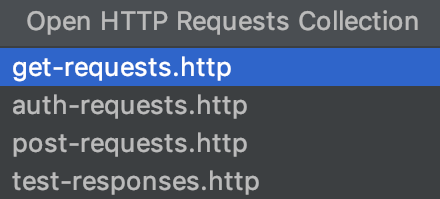
Convert cURL requests
If you are working with cURL requests, you can convert between cURL requests and the HTTP request in Editor format.
Convert cURL to HTTP request
Paste the cURL request into an HTTP request file. WebStorm will convert it to the HTTP request format and leave the original cURL request commented out for later reference.

Alternatively, click
on top of the HTTP request editor panel and select Convert cURL to HTTP Request.
In the Convert cURL to HTTP Request dialog, type or paste the cURL request that you want to convert.
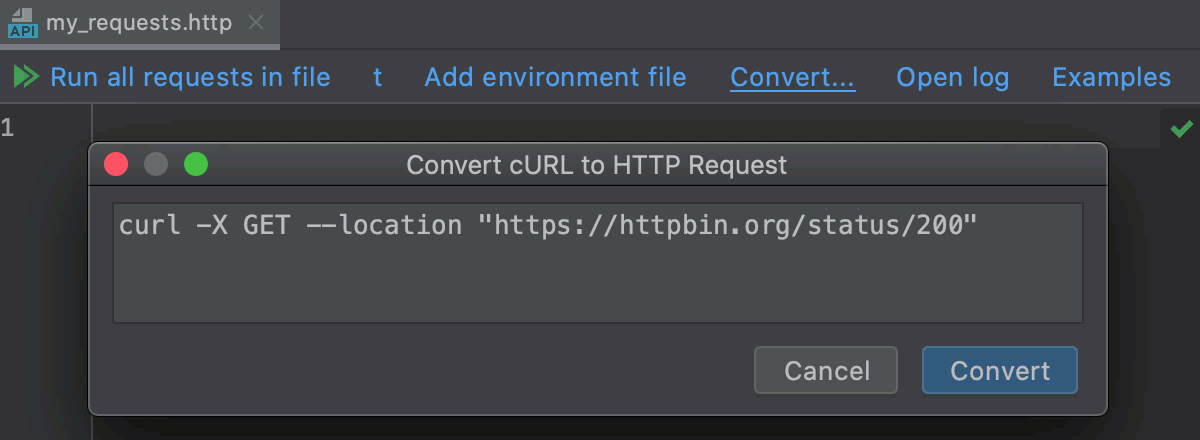
Consider the following example cURL request:
WebStorm will convert it to the following:
The converter supports the following cURL options:
Option | Description |
|---|---|
The request method to use. | |
The request header to include in the request. | |
The user's credentials to be provided with the request, and the authorization method to use. | |
The data to be sent in a POST request. | |
The multipart/form-data message to be sent in a POST request. | |
The URL to fetch (mostly used when specifying URLs in a config file). | |
Defines whether the HTTP response headers are included in the output. | |
Enables the verbose operating mode. | |
Enables resending the request in case the requested page has moved to a different location. |
Convert HTTP request to cURL
Put the caret at the HTTP request that you want to convert to cURL format.
Click Alt+Enter and select Convert to cURL and copy to clipboard.
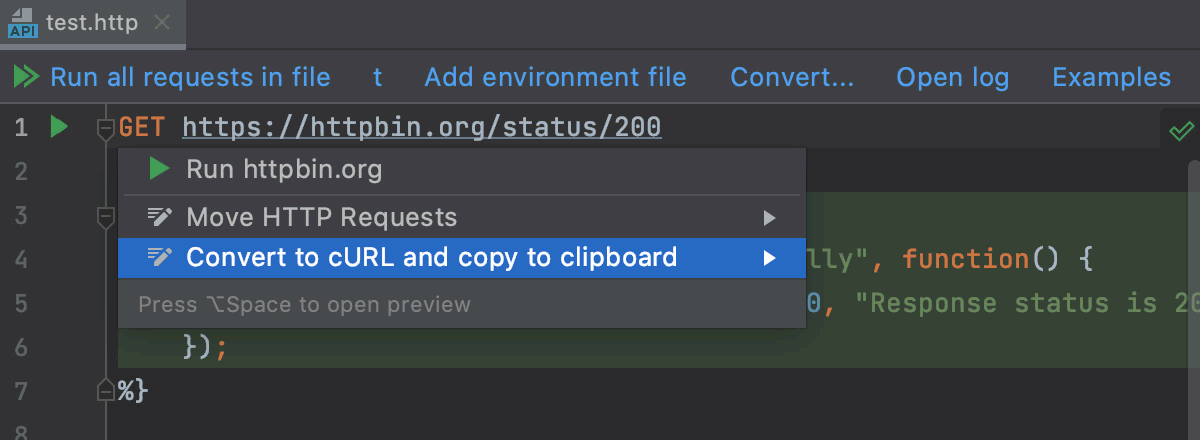
Alternatively, you can click the Convert shortcut link on top of the HTTP request editor panel and select Convert HTTP Request Under Caret to cURL and Copy.

This will generate a cURL request based on the HTTP request and copy it to the clipboard.
Generate requests using context action
You can quickly generate an HTTP request if you have a URL starting with http or https in your code string literals or in JSON, YAML, TOML, and Properties files.
Click a URL and press Alt+Enter.
In the context menu that opens, click Generate request in HTTP Client.
This will create a new GET HTTP request to the specified URL in the generated-requests.http scratch file.

Use response handler scripts
With response handler scripts, you can programmatically react to a received HTTP response. By using these scripts, you can automatically process the received data as well as validate it against the conditions that you specify. Response handler scripts are provided as a part of the request within the HTTP request file and are executed as soon as a response is received. To view the response handling examples, open the Requests with Authorization or Requests with Tests requests collections.
You can insert a response handler script into your request either in-place or by referring to an external file.
Insert the script into the request
To insert the script in-place, prepend it with
>and enclose it in{% %}:GET host/api/test > {% // Response Handler Script ... %}To insert the script from an external file, prepend it with
>:GET host/api/test > scripts/my-script.js
Response handler scripts are written in JavaScript ECMAScript 6, with coding assistance and documentation handled by the bundled HTTP Response Handler library. For in-place scripts, this functionality is enabled automatically. For external scripts, you need to enable it manually.
Enable JavaScript coding assistance for response handler scripts
Open the script file in the editor.
In the context menu, choose Use JavaScript Library | HTTP Response Handler.
The HTTP Response Handler library exposes two objects to be used for composing response handler scripts:
The
clientobject stores the session metadata, which can be modified inside the script. Theclientstate is preserved until you close WebStorm. Every variable saved inclient.globalasvariable_nameis accessible to subsequent HTTP requests as{{variable_name}}.responseholds information about the received response: its content type, status, response body, and so on.
To open the HTTP Response Handler library in the editor, position the caret at the library object and press Ctrl+B.
Response handler scripts can include tests, which lets you use the HTTP Client as a testing framework. To create a test, invoke the client.test(testName, function) method. Inside the test, you can assert a condition by invoking the client.assert(condition, message) method, for example:
Execute HTTP requests
If you are going to test your own web service, make sure it is deployed and running.
If you have environments defined, select an environment in the Run with list on top of the request's editor panel.
In the gutter, click
next to the request.
If you have multiple HTTP requests defined in an .http file, you can run all of them sequentially. To do this, click on top of the request's editor panel.
When a request is executed, WebStorm automatically creates a dedicated temporary HTTP Request run/debug configuration for it. You can save it as a permanent run/debug configuration if necessary.
Open a request in the browser
You can open an HTTP request in the browser specified on the Web Browsers and Preview page of the Settings dialog (Ctrl+Alt+S).
Press Alt+Enter and select the Open in web browser intention action.
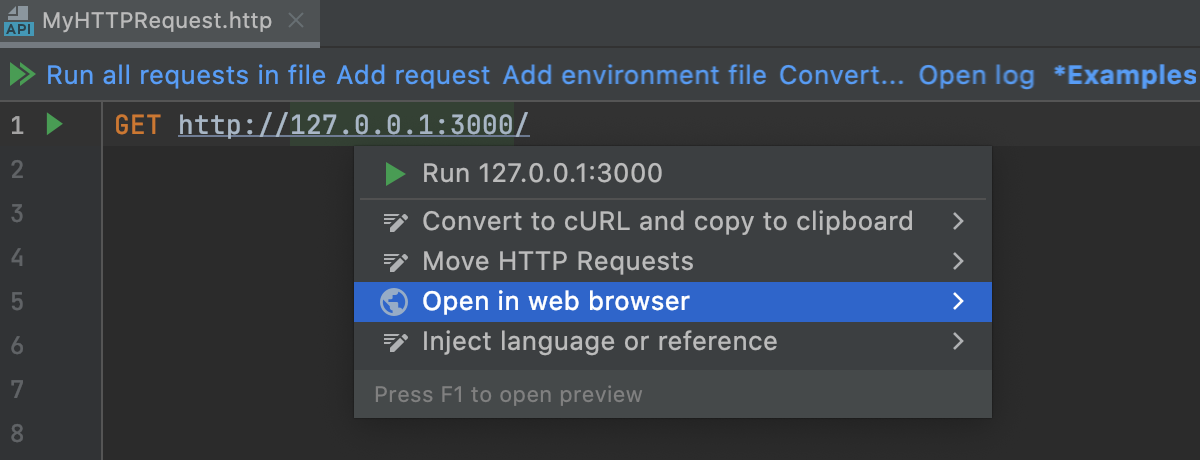
Work with HTTP request run/debug configurations
When you execute an HTTP request from the editor, WebStorm automatically creates a temporary run/debug configuration with the request parameters. A temporary run/debug configuration works the same way as a permanent run/debug configuration. You can change its settings using the Run/Debug Configuration dialog and optionally save it as permanent.
Modify an HTTP Request run/debug configuration
Do any of the following:
In the editor, right-click a request and in the context menu, select Modify Run Configuration.

Alternatively, choose from the main menu, and select the needed run/debug configuration in the HTTP Request list.
Change the needed configuration parameters:
In the Environment list, select an environment that will define the set of environment variables used in the request.
In the File field, provide the path to the HTTP request file. You can type the path manually and use path completion Ctrl+Space as you type, or click
and select the required folder in the dialog that opens.
If your request file contains multiple requests, in the Request list, choose the name of the request to execute.
Save a temporary HTTP Request run/debug configuration
In the Run/Debug Configuration selector, choose .
In the Run/Debug Configuration dialog, select the configuration and click
.
Execute a request using a run/debug configuration
In the Run/Debug Configuration selector, select the desired run configuration. Then click
on the main toolbar or press Shift+F10.
Press Alt+Shift+F10, select the desired run configuration from the list, and press Enter.

View responses from web services
When you execute an HTTP request, WebStorm automatically saves the response into a separate file under the .idea/httpRequests/ directory. You can view the 50 most recently stored responses and navigate to the corresponding files using the requests history. If the request was executed from a scratch file, the link to its response output is also added below the original request:

View a received response
Switch to the Services tool window, which opens automatically as soon as a response is received.
By default, the server response is shown in the format specified in the request header via the content-type field. To have the response converted into another format, click
and select Text, JSON, XML, or HTML.
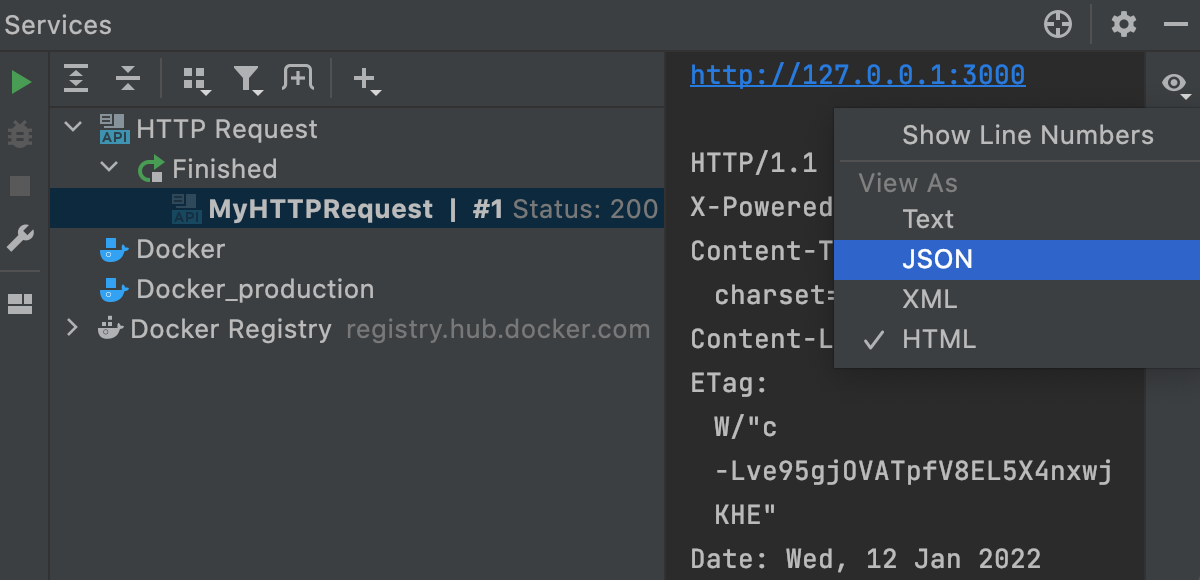
If the response contains a binary file, this file is also saved under the .idea/httpRequests/ directory. If the response is an image, you can see its preview in the Services tool window.
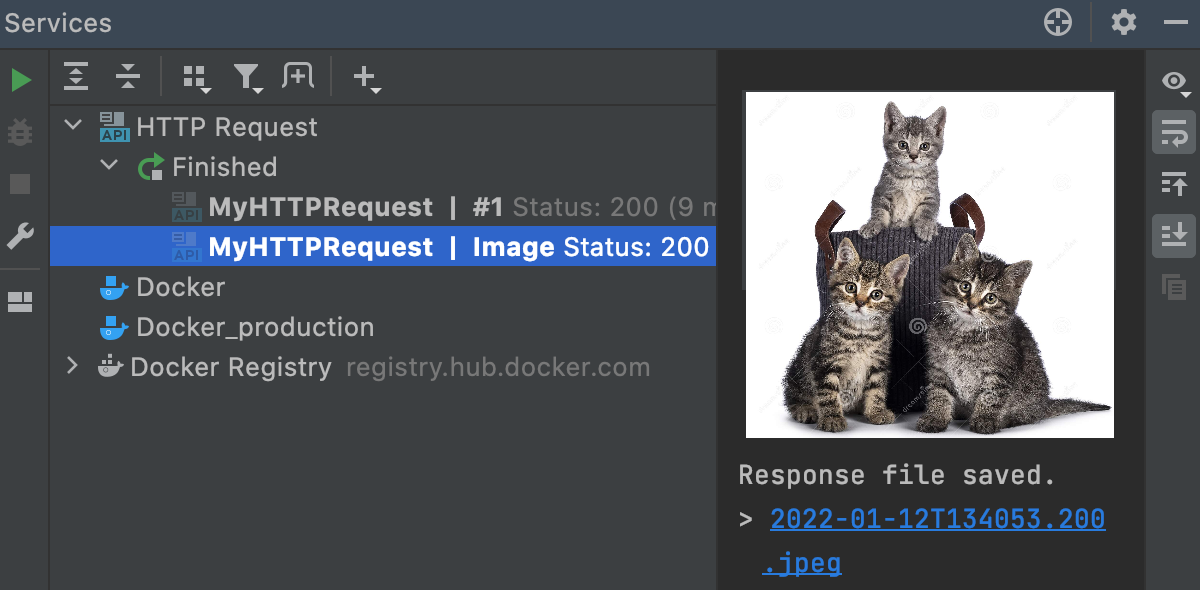
If you have a response handler script, the results of the tests executed as part of this script are displayed on the Tests tab of the Services tool window. You can click each of the tests to quickly navigate to the test source code in the corresponding response handler script.
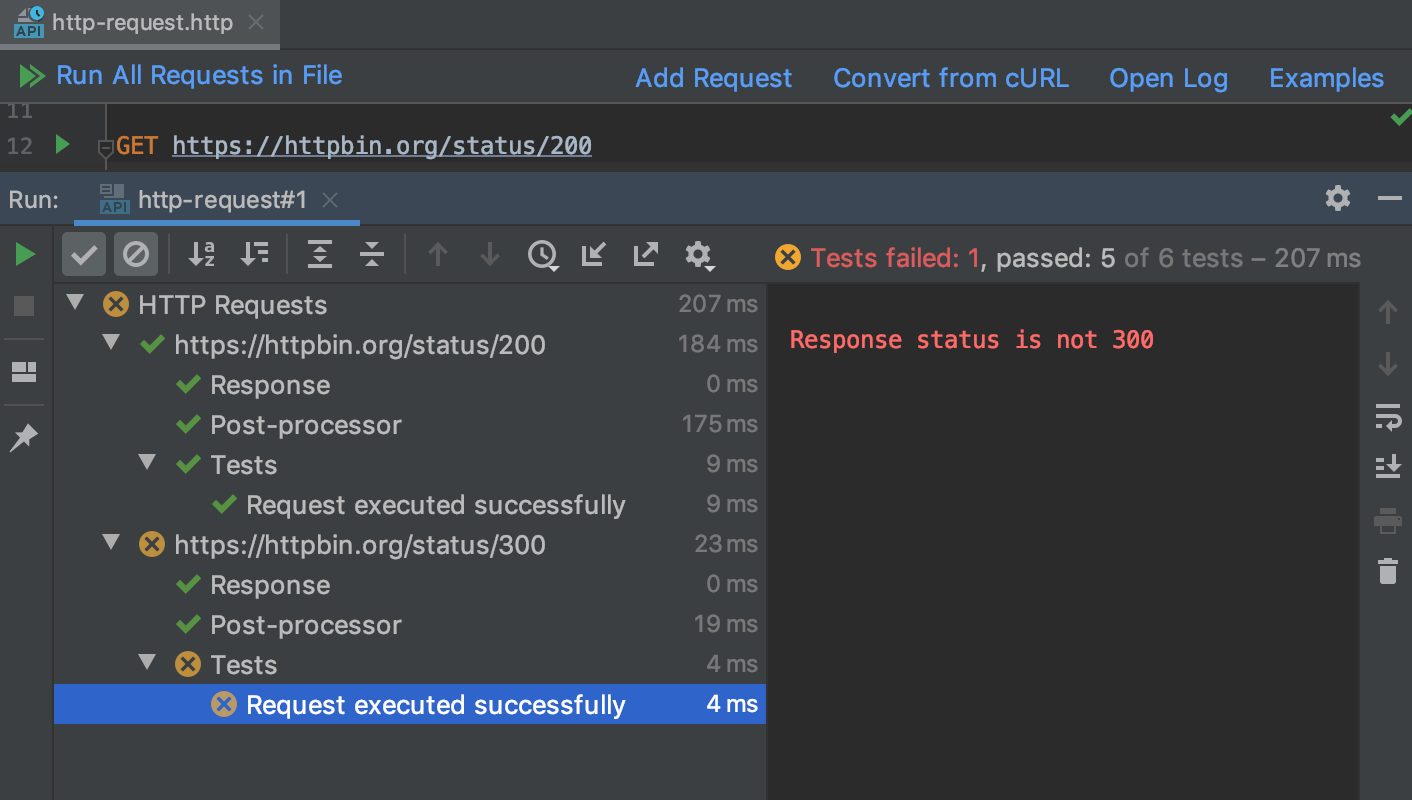
If you subscribe to an event stream, WebStorm displays events in the Services tool window. Here, you can also view the status of the client-server connection and terminate it by clicking . Depending on the content type (either
text/event-stream or application/x-ndjson), the response will be formatted as plain text or newline-delimited JSON. You can write a response handler script to process each line of the event stream.

Redirecting stream events to a file is currently not supported.
Open a response file in the editor
Position the caret at the link to the response you want to open.
Choose from the main menu, or press Ctrl+B or F4
Alternatively, you can Ctrl+Click the response line: 
Compare responses in a scratch file
When a request is executed from a scratch file, the link to the response output file is added below the original request.
Do any of the following:
Position the caret at the link to the response file. Press Alt+Enter and select the Compare with <response name> intention action.
Click
in the gutter and select Compare with <response name> from the list:

Compare responses in the request history
When a request is executed from a physical file, the link to the response output is added to the requests history.
Position the caret at the link to the response file. Choose from the main menu, or press Ctrl+B or F4 to open this file in a new editor tab.
Choose from the main menu, or press Ctrl+D. WebStorm will prompt you to open a response file from the httpRequests folder.
Select the response file you would like to compare the current file with and click Open.
The two response files will be opened in the Differences viewer allowing you to compare their contents:
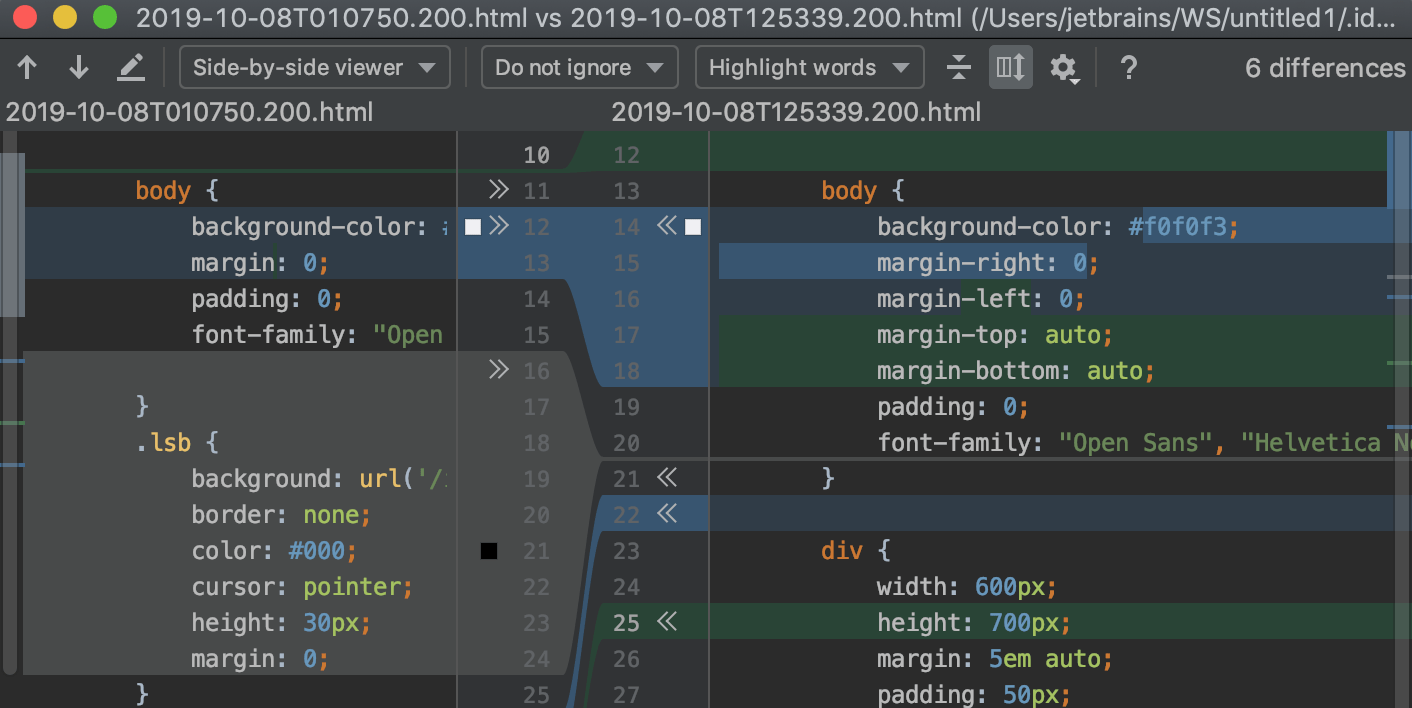
View request history
WebStorm automatically saves the 50 recently executed requests into the http-requests-log.http file, which is stored on the project level under the .idea/httpRequests/ directory. With requests history, you can quickly navigate to a particular response as well as issue any request again. If a request is issued again from the request history, its execution information and the link to the response output are added to the top of the request history file.
Open request history
Click
on top of the request's editor panel.
Select from the main menu.
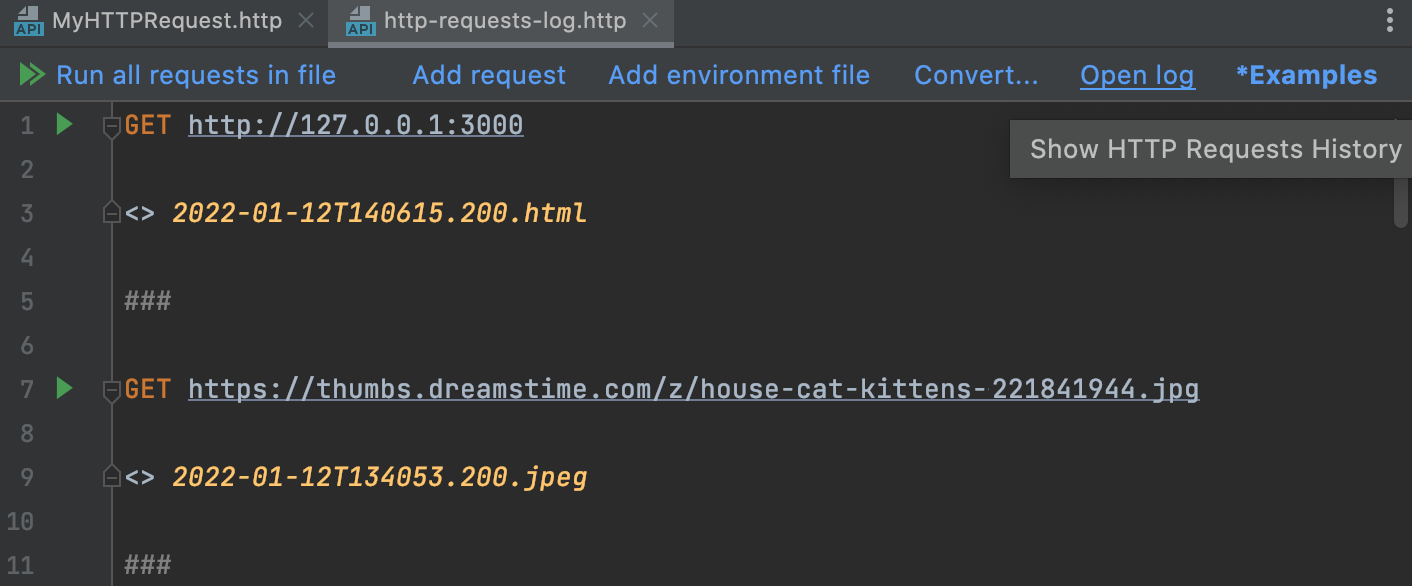
Redirect output to a custom file or directory
The HTTP Client can redirect output to a custom file or directory. It supports two operators for force and soft redirects:
The
>>operator always creates a new file, adding an-nsuffix to a filename if the requested filename already exists.The
>>!operator rewrites the file if it already exists.
Manage cookies
The cookies received through a response are automatically saved into the dedicated http-client.cookies file under the .idea/httpRequests/ directory. The number of cookies that can be saved is limited to 300. The name and value of a cookie are automatically included in each subsequent request to the URL that matches the domain and path specified for the cookie, provided that the expiry date has not been reached.

If you want to set custom cookies in an HTTP request, you can use the Cookie header. Enter your cookies as a list of name=value pairs separated by a semicolon, for example:
gRPC requests
The HTTP Client supports gRPC requests. For the HTTP Client to treat your requests as gRPC requests, start them with the GRPC keyword.
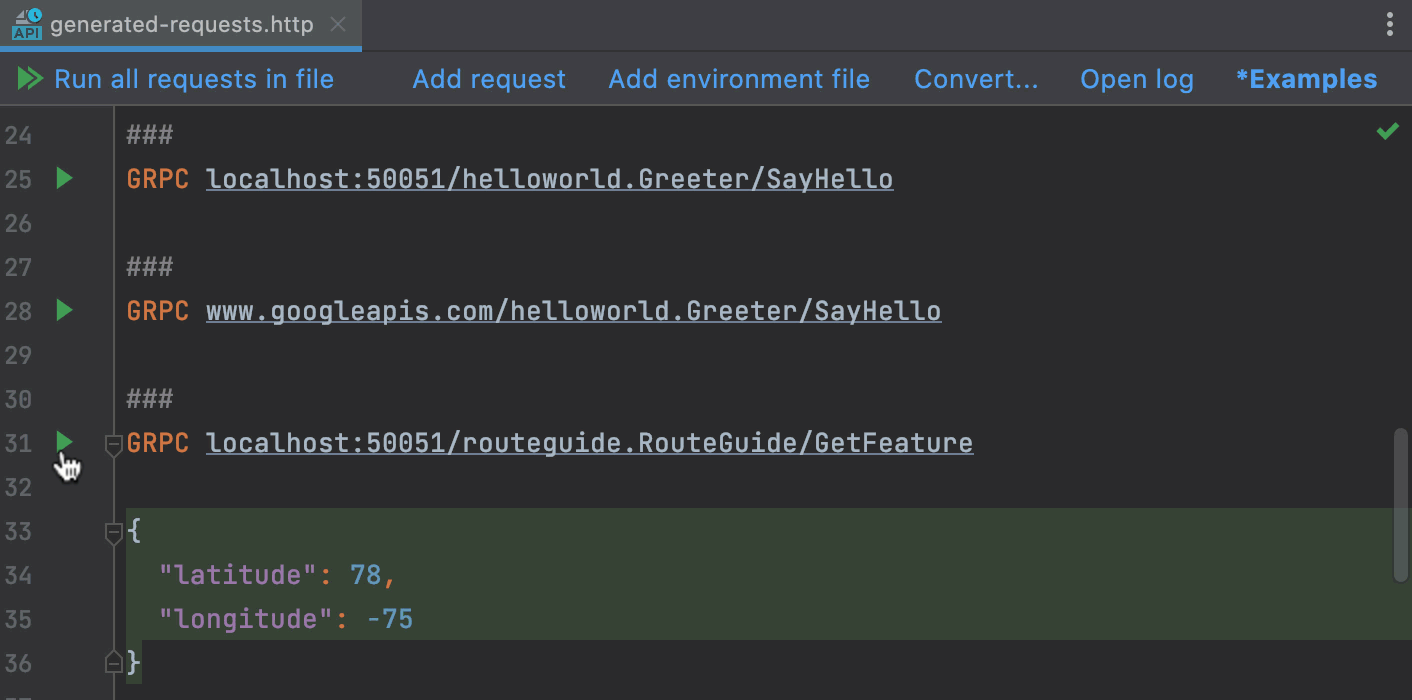
Based on a .proto file, WebStorm provides completion for gRPC: all known gRPC services, unary and server-streaming methods of a particular server, and fields of accepted messages in the request body. If you don’t have a .proto file in your project, code completion can still be available if a server supports gRPC reflection, which provides HTTP clients with information about accessible services.

Before you start
Install the Protocol Buffers and gRPC plugins on the Settings | Plugins page, tab Marketplace, as described in Installing plugins from JetBrains repository.
Generate a gRPC request from PROTO files
In the PROTO file, click the Generate icon near the RPC method.
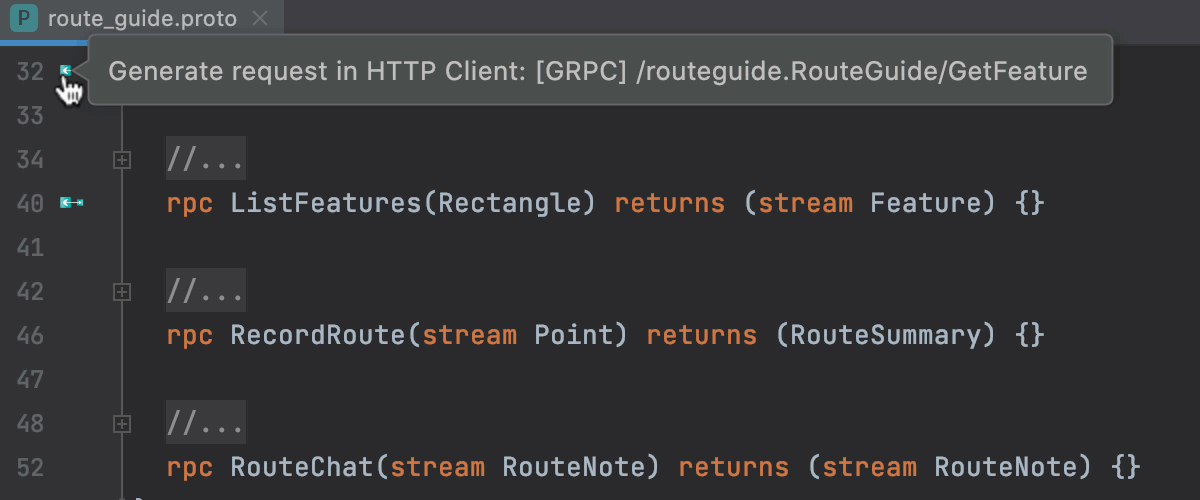
Send gRPC metadata
Below your
GRPCrequest, enter gRPC metadata using the following syntax:Metadata-key: Value.For example:
GRPC localhost:8080 X-Myhostname: Example.org
WebSocket requests
The HTTP Client supports WebSocket requests. For the HTTP Client to treat your request as a WebSocket request, start it with the WEBSOCKET keyword followed by a server address. The request has the following structure:
To speed up composing a WebSocket request, you can:
Click
on top of the editor panel of an .http file and select WebSocket Request.
In an .http file, type
wsrand press Enter to apply the WebSocket live template.
Send multiple messages
Use the
===separator to send multiple messages:{ "message": "First message sent on connection" } === // message separator { "message": "Second message" } === { "message": "Third message" }
Send messages after the server response
Before a message, enter
=== wait-for-server.This will make the HTTP Client wait for the server response before sending the message. You can wait for multiple responses by repeating the
=== wait-for-serverline. For example, the following message will be sent after 3 server responses:=== wait-for-server === wait-for-server === wait-for-server { "message": "This messages is sent after 3 server responses" }
Send messages interactively
Once you have initiated a connection, you can interact with your server right from the Services tool window. You can send messages and view server responses to each new message.
In the Services tool window, select an opened connection.
In the lower part of the window, under Message to be sent to WebSocket, enter the message content.
To the right of it, select the message format: plain text, JSON, XML, or HTML.
Press Ctrl+Enter to send the request.
In the upper part of the window, you'll see the server response.

GraphQL
WebStorm provides support for sending GraphQL operations in the HTTP request body. You can send them over HTTP or WebSocket.
Compose an HTTP request with GraphQL query
In an .http file, enter the
GRAPHQLkeyword followed by a server address.In the request body, compose your GraphQL operation (query, mutation, or subscription), for example:
### HTTP request with GraphQL query GRAPHQL http://localhost:8080/graphql query { toDos { title, completed, author { username } } }
To speed up composing an HTTP request with a GraphQL query, you can:
Click
on top of the editor panel of an .http file and select GraphQL Query Request.
In an .http file, type
gqlrand press Enter to apply the GraphQL live template.
Use GraphQL variables
In the HTTP request body, you can use GraphQL variables if you want to pass some dynamic data separately from the query string.
After the query part, enter a JSON variables dictionary:
query ($name: String!, $capital: String!) { country(name: $name, capital: $capital) { name capital } } { "name": "France", "capital": "Paris" }You can also use HTTP Client environment variables as GraphQL variable values. For example, in this JSON,
"{{Author}}"is an environment variable; its value at runtime depends on the environment that you select while sending the request:{ "author": "{{Author}}" }
Configure proxy settings
In the Settings dialog (Ctrl+Alt+S), choose System Settings under Appearance & Behavior, then choose HTTP Proxy.
In the HTTP Proxy dialog that opens, select Manual proxy configuration and specify the following:
Enter the proxy host name and port number in the Host name and Port number fields.
To enable authorization, select the Proxy authentication checkbox and type the username and password in the corresponding fields.
Set up client SSL/TLS certificate
If an HTTP server requires SSL/TLS authentication for secure communication, you may need to specify the client certificate before sending an HTTPS request. In the HTTP Client, you can set up the client certificate using the private environment file.
Specify path to certificate
In an .http file, in the Run with list, select Add Environment to Private File….
In the http-client.private.env.json file that opens, add the
SSLConfigurationobject to the needed environment. InclientCertificate, enter a path to your client certificate. If a certificate key is stored in a separate file, enter its path inclientCertificateKey. For example:{ "dev": { "MyVar": "SomeValue", "SSLConfiguration": { "clientCertificate": "cert.pem", "clientCertificateKey": "MyFolder/key.pem" } } }Alternatively, you can describe
clientCertificateandclientCertificateKeyas objects, which lets you specify the certificate format in addition to the path. For example:{ "dev": { "SSLConfiguration": { "clientCertificate": { "path": "file.crt", "format": "PEM" }, "clientCertificateKey": { "path": "file.key", "format": "DER" } } } }
Set up a certificate passphrase
If you used a passphrase when generating your client certificate, you should provide it to the HTTP Client.
In the http-client.private.env.json file, add
"hasCertificatePassphrase": trueto theSSLConfigurationobject, for example:{ "dev": { "SSLConfiguration": { "clientCertificate": "file.crt", "hasCertificatePassphrase": true } } }Click
in the gutter or, with the caret placed at
hasCertificatePassphrase, press Alt+Enter and select Set value for 'Certificate passphrase'.In the window that opens, enter your certificate passphrase.

You can omit the second step if you do not want to enter the passphrase now. In this case, WebStorm will prompt you to enter the passphrase when you execute an HTTPS request.
Disable certificate verification
For development purposes, you may have a host with self-signed or expired certificates. If you trust this host, you can disable verification of its certificate.
In the http-client.private.env.json file, add
verifyHostCertificate": falseto theSSLConfigurationobject. For example:{ "sslTest": { "SSLConfiguration": { "verifyHostCertificate": false } } }
If you run a request with this environment, WebStorm will not verify host certificates.